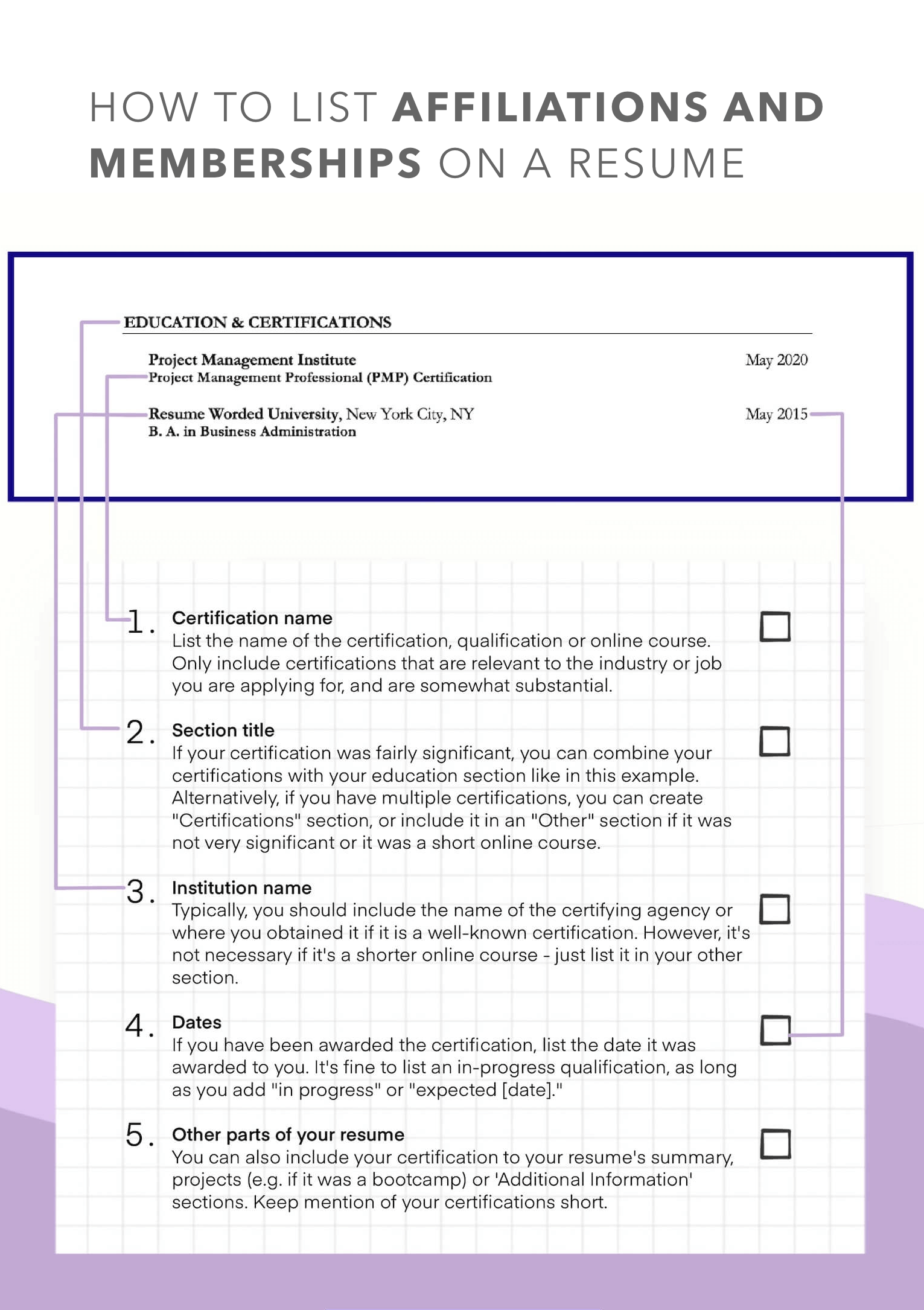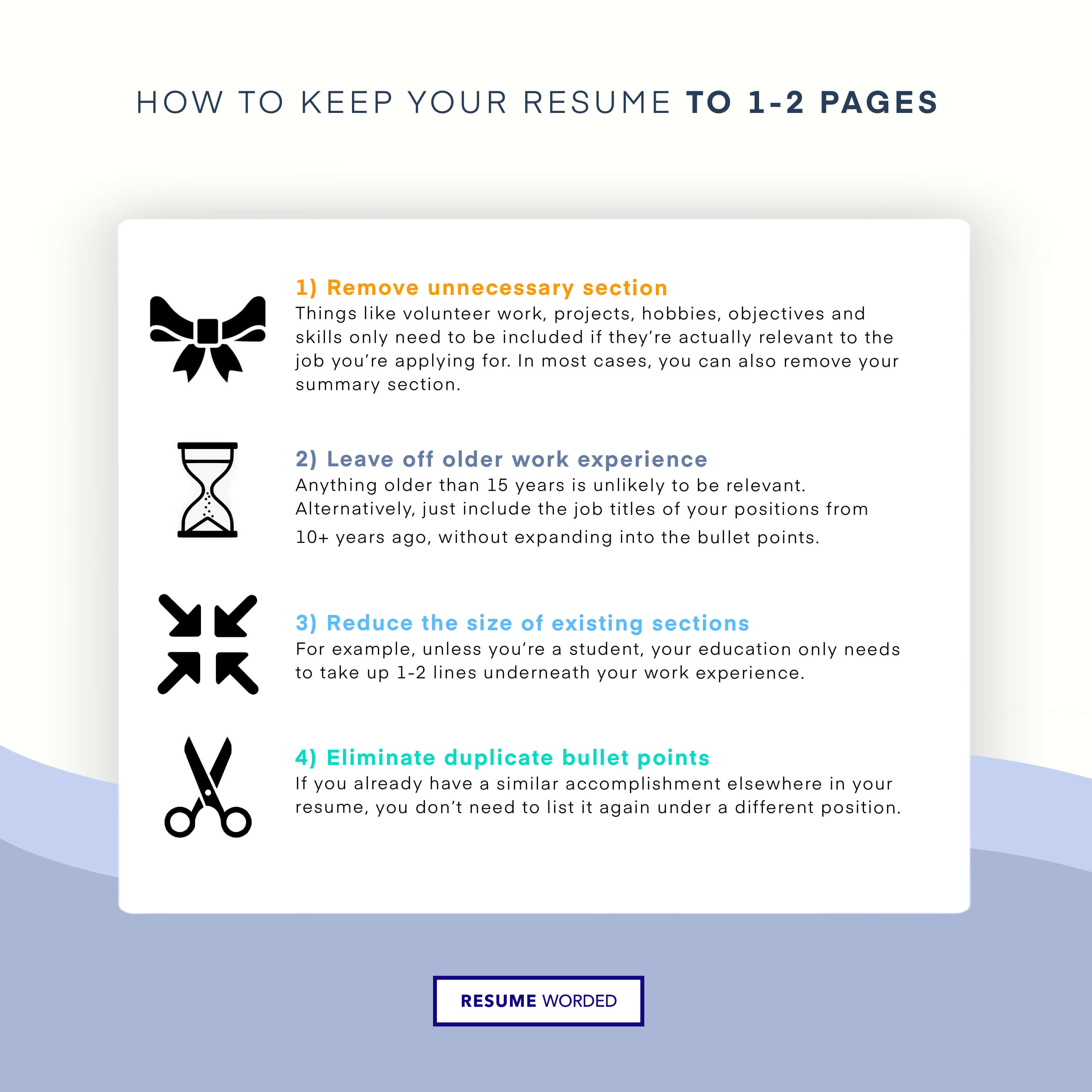There’s more to a successful resume than a list of jobs. While they may not take up a lot of space, professional affiliations can make or break a resume, especially if you’re in an industry like law, education, or healthcare where professional associations are standard.
Professional affiliations can include:
- Membership in a professional organization
- Licenses
- Certifications
- Community involvement
- Volunteering
- Board memberships
Below, we’ll cover what professional affiliations and memberships do (and don’t) belong on your resume, how to list them, and industry-specific tips for making the most of professional associations on your resume.
How to add professional affiliations to a resume
First, here’s a quick-start guide on how to include professional affiliations on your resume:
- Make a list of all of your professional memberships, licenses, certifications, affiliations and community involvement. This is just the brainstorming stage — these may or may not all end up in your resume.
- Now, take a look at the job description and scan for mentions of any of these. Anything that’s listed in the job description should automatically go in your resume.
- Search for the job title in our skills and keywords finder to identify any essential skills or certifications — including hidden “must haves” not listed in the job posting.
- Decide where to list the professional affiliation (more details on how to do that below). In general, the more important it is, the higher up on your resume it should go.
- List the title of the professional affiliation, the organization it belongs to (i.e. your membership), and the date you obtained it. If it’s something that needs to be up to date, include specific dates, like “2012 — Present.”
- Run your finished resume through a free resume checker to see how your resume compares to the job description and look for any professional affiliations you may be missing.
Now, let’s take a look at where on your resume these professional affiliations belong.
Examples of certifications and professional affiliations on a resume
There are a few places on your resume where you can list professional affiliations. They can go in your:
- Professional affiliations section
- Resume header
- Summary
- Additional information section
Let’s take a look at what each of those options can look like.
Listing professional affiliations in their own section
When: If you want to list multiple professional affiliations or memberships or just want to make sure they stand out.
How: Beneath your work experience, create a separate section titled “Professional Affiliations” or "Professional Memberships". List any relevant affiliations there along with the organization and dates.
Example:
Listing professional affiliations in a resume header
When: If the professional affiliation is absolutely essential to the position and you won’t be considered for the role without it.
How: At the very top of your resume — underneath your name but above your contact details — add a line that lists the professional affiliation, for example, “Certified Nursing Assistant.”
Example:
Listing professional affiliations in a resume summary
When: If you hold a professional affiliation that is particularly well-known or important to the role.
How: Underneath your contact details, write a short (3-5 line) summary of your key skills and experience, including any professional affiliations.
Example:
Listing professional affiliations in an additional section
When: If they aren’t essential and you want the bulk of your resume to focus on more relevant information.
How: At the bottom of your resume, create a section titled “Other” or “Additional Information.” List anything that didn’t make the cut in a more prominent resume section, including professional affiliations and memberships.
Example:
If you’re wondering if you’ve listed your professional affiliations the right way, upload your resume to the tool below — it’ll scan it and let you know if you’ve listed affiliations, board memberships, licenses and volunteer work the right way. It’ll also let you know which of these belong on your resume and which ones to remove.
What professional affiliations to list
Just because you have a professional affiliation or you have a membership to a professional organization, that doesn’t mean it automatically belongs on your resume. So, when should you list a professional affiliation on your resume?
Do list professional affiliations if:
- They’re essential to the role. Any license, certification, or professional membership that is required for the position — for example, medical licenses for healthcare positions — absolutely must be listed on your resume.
- They strengthen your candidacy or speak to your expertise in the field. Volunteer affiliations and board memberships are a good example of this.
- They’re relevant to the industry or show transferable skills, even if they aren’t directly required. For example, listing a teaching certification for a non-teaching role in education or a position where you’ll regularly be training other people is optional, but it can be a plus.
Don’t list professional affiliations if:
- They’re not relevant to the position you’re applying for — no matter how impressive they sound. Listing the Bar Association for a legal position is a must, but if you’re changing careers and now applying for a web development role, leave it off.
You should also try to include relevant keywords on your resume. Use the skills search tool below to find essential skills and keywords for the job.

Industry-specific tips and examples
Education professional affiliations on a resume
Official teaching credentials, licenses, and other professional affiliations required for educational roles will vary from state to state. Even if not strictly required, it’s always a good idea to list these on your resume (and in some cases, holding a degree or certification may allow you to negotiate a higher salary).
Depending on your location, teaching roles may also require professional registration with a governing association — make sure yours is current before listing it.
Healthcare professional affiliations on a resume
If you’re applying for a healthcare role that requires a specific license or degree, make sure you list it on your resume. It’s always a good idea to list these in your resume title, but make sure you use the correct one — for example, “Licensed Professional Nurse” is a different role from “Registered Nurse,” and both require separate certifications.
Law professional affiliations on a resume
If you intend to practice law, you’ll need a degree and admission to the bar in the state you intend to practice in. In some cases, state admission is transferable, while in other cases you may need to retake the exam if you move. You can still list out-of-state law associations on your resume, but should specify if you hold (or are pursuing) state-specific affiliations.
Union professional affiliations on a resume
If the job you’re applying for requires you to be a member of a union, definitely list it on your resume. On the other hand, if it’s not required, union affiliation may cause some hiring managers to be wary. Feel free to list these if you want to screen out non-union-friendly employers, otherwise it might benefit you to leave them off.









